
There is so much more to sights, sounds, and feelings of triumph when it comes to climbing a lofty mountain like Mt. Madjaas. Close your mouth; and open your ears, mind, and heart. Suddenly, the mountain will show you her wonders. Wonders that are indescribably beautiful and soul-filling.
In every climb, we want to grab the opportunity to see the rising sun. As such, we woke up at 3 AM, a couple of hours before sunrise. We donned on our warmers and windbreakers as the pre-dawn air in this altitude is quite moist and frigid. In the darkness, with only the glow of our headlamps leading the way, we made our bid to the Mt. Madjaas summit.
Climbing in complete darkness was quite risky; Tatay Josue consistently warned us of sinkholes and ravines which we couldn’t see. Furthermore, the micro-climate produced a slight shower, which made the terrain quite slippery.
Unfortunately, our camera can’t capture the incredibly rugged terrain on the way to the peak. So we’ll just post photos of what the terrain looks like a little later on our way back to camp.
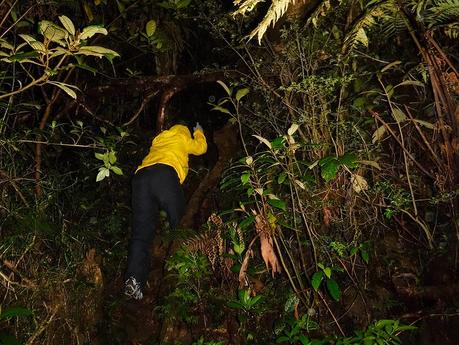
But with care and respect for Mother Nature, all went well. At 5:30 AM, we stepped on the sacred summit of Mt. Madjaas, 2,117 meters above the sea.
What’s the matter, Sweetie? Cold?

We reached the summit just as the sun was about to rise. Perfect! And what a gentle sunrise it was!
It’s like life. Yes, there will be trials and tribulations that you’ll have to face. But if you keep your head up high and never quit, the success and happiness that you’ve always sought after will come to you—as sure as the sun rises every day.
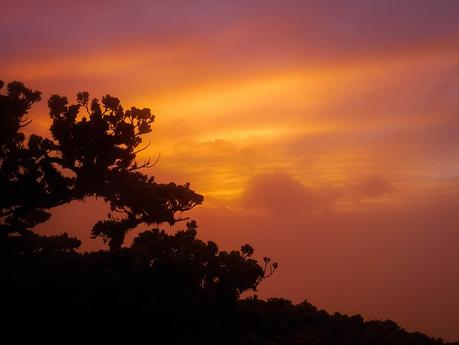
The pink and orange glow of real dawn was quite invigorating after spending an entire day inside a really thick forest. We also saw the canopies of rare trees, perhaps some species of dipterocarp trees.

A few steps from the tree-walled peak is a small view deck that offers the successful summitter an encompassing view of Culasi. During our climb, however, we were blessed not with a view of the lowlands but with a spectacular sea of clouds.

After staying for half an hour at the summit, we began our descent back to Camp 3. There was sufficient light for our camera so that we can take clear photos. As the morning light shone on the summit trail that we walked on a few hours ago, we clearly saw just how rough, tangled, and dangerous the trail is! Yet, we were able to reach the top of Mt. Madjaas despite the difficulty!
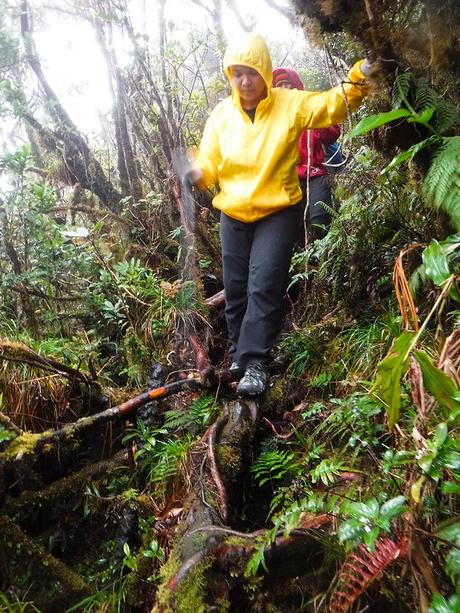
On our way down and just a short distance from the summit, Tatay Josue led us to a secondary peak called “False Peak.” It’s just a very small promontory with enough space for two people. Surrounding us are cliffs that go all the way to the mountain’s base.

Strange trees abound! Have you seen that blockbuster movie Avatar? We swear, this could have been Pandora!
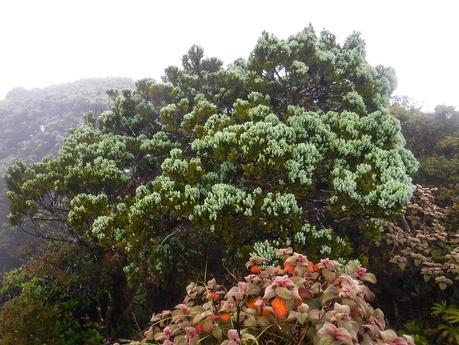
We exercised extra care as we descended from the summit. You see, a climber’s mindset changes as he goes down the summit. He becomes complacent, careless, and eager to finish the adventure. And that’s when preventable mistakes happen.
Many successful mountaineers and adventures end in tragedy because of that mindset.

Lose soil, slippery rocks, tangled roots—the descent was really a challenge. You can’t go fast here.

Can you imagine that we traversed this ravine in pitch darkness a few hours ago? Also, you can’t see it from the photo below, but that trail is dotted with several sinkholes!

The high altitude, fertile soil, and unique mountain environment of Mt. Madjaas allowed exotic flora to grow. Check out this fiery fern-like plant.
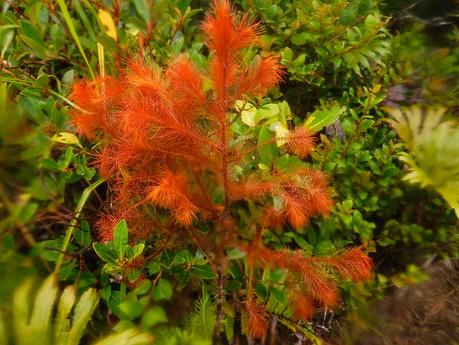
Another attraction of Mt. Madjaas is this “Bonsai Forest” consisting of these gnarly dwarf trees. Such trees are abundant here due to the high altitude and their relatively exposed position on the slope. They altogether create a surreal landscape.

These dwarf trees are home to pitcher plants. The smell and the look of pitcher plants attract insects, reptiles, and small animals to the slippery lip of the pitcher plant. Once the prey slips, it is slowly consumed by the plant via its digestive insides. Waxy scales and downward pointing cilia prevent the prey from crawling back out of the pitcher plant.
These pitcher plants often grow in places where the soil lacks important nutrients for them to survive. Thus, the plants supplement their nutritional requirements through their prey.

A quarter to 8 AM, we arrived back at Camp 3. Through experience, we have become so efficient at this process that it only took us less than an hour to prepare breakfast, eat our food, break camp, and pack up. At 8:30 AM, we were ready to go back to civilization.

On the way back, we stopped by the grassy View Deck to rest for a bit and to have a final glimpse of the lowlands from this altitude.

The telltale signs of the habagat season have arrived. Yet, the weather was warm enough to lift and part the clouds, revealing swatches of mountain ranges, farmlands, and highland communities far below us. Such a magnificent sight that only a few have seen.

From here, we could see a faint outline of the forest-covered peak of Mt. Madjaas. In silence, we thanked the mountain for letting us experience her well-hidden but indescribably spectacular treasures. We hope that the people of Antique and the entire Panay island for that matter realize that they have a beautiful jewel to protect, nurture, and be proud of.

Rather than go back the way we came from (and risk crossing those ravines again), we decided to go back via the longer but safer Old Trail. Tatay Josue totally agreed; he also wanted us to experience other views and terrain of Mt. Madjaas. Thus, this climb became an adventure-filled traverse.
The Old Trail is largely unused thanks to the establishing of the shorter New Trail (the trail we used for the first two days of the climb). As such, thick foliage has overgrown the barely-visible trail.

We were following Mt. Madjaas’s ridge, but we still encountered lots of steep ascents and agonizing descents. Much of trail consists of huge overlapping roots and gnarly branches that presented quite a challenge. Yes, we had to often wrestle with the elements of the forest to move forward!

But the isolation of the Old Trail helps retain the mountain’s surreal and ethereal aura. Walking through the misty trail seemed like visiting a lost and hidden kingdom of fairies and gods.

Mossy trees are indicative of a healthy, ancient forest. Beneath these trees’ thick canopies is an thriving and healthy ecosystem of constant decay and renewal. Sometimes, the best way to preserve these biospheres is to simply step aside and let Nature do the work.

The Old Trail also hugs the side of deep ravines by a razor’s edge. Be very careful when traversing these ridges as thick plants actually hide the edges.

From clear ridges like this, we realized that Mt. Madjaas is just the “front door” of an extremely vast and virgin mountain range. Several other forest-covered mountain ranges connect through the Madjaas range like tributaries of a river.
Rainforests harbor a lot of secrets and resources. Somewhere in these thick canopies are flora, fauna, bacteria, and geological minerals that may hold the answers to many of society’s problems—cures for terminal diseases, raw materials for bio-degradable items, bacteria that may metabolize plastics, and more.

We have been walking and scrambling along the trail for more than 9 hours. We can actually hear our guts rumbling. With a huge sigh of relief, we reached our lunch spot, a clear area of a dried-up river. We took off our heavy packs, a huge relief to our aching shoulders, and heated up food that we pre-cooked earlier.
The hot meal of fried pork and hot noodle soup re-energized our bodies. We need the energy as we still have a long way to go.

No time for dilly-dallying or a siesta. The distant and ominous sound of thunder coupled with an ever darkening sky signaled a mighty thunderstorm coming our way. We packed up and continued our way. We had to get out of ridges like these before the approaching thunderstorm hits the mountain.

We walked as fast as we can, but the thunderstorm was able to overtake us. In just a few minutes, we were drenched. Fortunately, we were back inside the forest and out of the ravines when the thunderstorm struck.
Check out that “tree.” That’s actually made out of intertwined branches rather than a single solid trunk!

The more we climb mountains, the more attuned we become to Mother Nature’s treasures. We found one—a pretty glittering bug. Its iridescent carapace shifted colors in the afternoon sunlight as it moved around its leaf home.
A living, crawling gem indeed!

What a big bug! We were quite afraid of it as Tatay Josue held the creature so we could take a shot. Does it bite? Nope! After taking this shot, Tatay carefully placed the bug in his nook.

At 4 PM, 13 hours since we started our summit bid, we saw a welcome and pleasantly familiar sight. Under the cover of light woods, we reached the junction of the Bantang River trail and the trail back home.

It was still a long way back home. Yet, we were absolutely relieved, happy, and triumphant as we exited the forest into a gorgeous sunset. It was like the sun smiled on us as a reward for our perseverance, respect, and sense of awe on Mt. Madjaas.

From up the shoulder, we could once again see Mararison Island from afar, now bathed with golden light.

It took us another 3 hours to descend down the hill and enter the warm sanctuary of Tatay Josue’s house. A couple of factors hampered our descent. One, Sweetie suffered the pangs of the injury that she incurred during our CHT Segment 3 hike. We had to take it slow to mitigate the pain and to avoid further injury.
Two, the batteries of our light sources started to wane out; Sweetie’s headlamp got completely drained. I forgot to replace mine with fresh batteries (which I had in my bag!), so we had to go down largely depending on our innate night vision. We used all the light sources we had in our disposal—our lighter, our lighter’s LED, and our USB-powered camp light.
Thankfully, at 8 PM, we finally arrived at Tatay Josue’s house where a hot meal of tinolang manok and steaming rice was waiting for us. After a refreshing cold shower and a liniment-assisted massage, we finally slept in a real bed with clean, fragrant sheets. Tatay and his family allowed us to sleep in one of their rooms, and it was the best snooze we ever had!

Another dream climb accomplished spectacularly! Climbing Mt. Madjaas was definitely fun and challenging, an adventure for each Filipino mountaineer. But more than that, the adventure reminded us that our country’s verdant mountains are glorious treasure troves that have been lovingly cultivated by Nature’s hands. In these huge mounds of earth are wonders to behold—wonders that inflame our imagination and kindle the love, passion, and drive to preserve our natural and cultural heritages.

- For acquiring permits to climb and guide fees, check out Part 1.
- For budgets and itinerary, check out Part 2.
Tips
Preparation
1. Mt. Madjaas is considered a major climb. Before climbing the mountain, make sure you fully prepare for such an undertaking. We strongly recommend climbing a couple of shorter mountains or taking a few long treks to condition your body to the rigors of the adventure.
2. During your practice climbs and treks, carry a mountaineering pack filled with your mountaineering gear (or bottles filled with water) so you can get used to the weight (remember, you are going to carry extra bottles of water and your food).
3. Ensure that you are fully hydrated for the trip. Also, we would recommend bringing hydration or salt tablets that you can add to your water to replenish lost ions during the climb.
4. A week prior to the climb, eat a carbohydrate-filled diet. Carbo-loading is crucial for stored energy, energy that you need for the climb. Get lots of carbohydrates from wheat bread, cereals, pasta, and rice. Don’t worry if your weight increases; you’ll get rid of that when you climb Mt. Madjaas.
5. If you’re suffering from an injury or ailment, see your doctor first and seek his advice before joining the climb. A sick, injured member of the team compromises not just the team’s enjoyment but also its safety.
6. Sleep well the night before the climb.
7. Be sure to prepare a meal plan to ensure you have enough food there. Usually, it takes 3 days to complete the adventure, so you have to stock on food. If you choose to follow our itinerary, your meal plan would look like below:
- First day – packed lunch, dinner
- Second day – breakfast, packed lunch, dinner
- Third day – breakfast, packed lunch, emergency food
Time-saving tip: You can prepare packed lunches the same time you prepare breakfast.
8. For your convenience, bring food that is easy and quick to prepare and does not spoil easily. If you want to bring more elaborate dishes, prepare and/or pre-cook the ingredients before the climb. Pack those ingredients in plastic bags or tubs.
9. Bring enough food so you can include the guide (and porter, if you hire one) in your meals.
10. You can bring extra equipment, but make sure you bring the items below:
- good-quality 3-season tent with fly sheet and ground sheet (can be shared with the group)
- cookset (can be shared with the group)
- burner (can be shared with the group)
- cold weather gear (warmer, thermal underwear, fleece jacket, windbreaker or winter jacket)
- extra clothes (1 set for climbing, 1 set for sleeping)
- swimwear (in case you want to swim in Bantang River)
- trekking shoes/boots
- light flip-flops (for walking around the campsite)
- sleeping bag or warm blanket
- earth pad (to insulate your body from the cold ground)
- raincoat, rain jacket, or poncho
- hat, scarf, and sunglasses (to protect yourself from the sun)
- extra empty 1.5 liter plastic bottles (1 for each person)
- water bottle for trail water (at least 1 liter)
- first aid kit
- hydration salts, table salt, or Gatorade (to avoid and relieve cramps)
- tourniquet (to relieve cramps. A strip of strong cloth will do)
- toiletries and sunblock
- toilet paper (for cleaning your cooking utensils)
- headlamp or flashlight
- whistle
- cellphone
- extra money
- trail snack
11. Waterproof everything (especially your clothes, cold weather gear, tent, gadgets, and batteries) by putting your items in dry-bags. If dry-bags are unavailable, wrap your items in plastic bags.
Water
1. Water sources are available at the Bantang River and Camp 3. Ask the guide if there are other water sources in the mountain.
2. Conserve your water intake, but do drink when you’re thirsty. Sip, don’t gulp, your water.
3. The nice thing about having water sources near the campsites is that you have all the water you need to clean your utensils, brush your teeth, wash your face, etc.
4. Be careful when bathing in Bantang River. The rocks are quite slippery.
Safety
1. Bad weather is the greatest threat in any climb, especially a major mountain such as Mt. Madjaas. Don’t hesitate to cancel your climb if there is a forecast of rain or storm; you can always rebook your climb.
2. Ensure that you stay dry because wind chill becomes even colder if you’re wet. Consequently, you’ll be more susceptible to hypothermia. At the first sign of rain, pull out and don your rain-protection gear immediately. Once you set up camp, immediately change into dry clothes if you somehow got wet.
If you’re drenched in sweat by the time you reach the camp site, change into dry clothes once you set up camp.
4. If you feel sick or if you develop cramps during the climb, don’t hesitate to ask the guide to stop so first-aid can be administered. Do not be a liability by keeping silent about your condition; remember that a sick or injured person is a liability and a safety hazard for the team.
5. Do not hesitate to crawl or to brace yourself down a difficult section of a trail if that seems to be the safest way for you to negotiate that section. Don’t follow your guide’s footing simply because the trek seems easy for them. Remember they climb that mountain frequently and are familiar with the trail features.
6. Mt. Madjaas’s forest is truly ancient. Thus, before gripping or holding roots, branches, and trunks, make sure that they are firm and solid. Many are rotten inside although they appear solid externally. As much as possible, avoid holding shrubs and grasses; they can’t hold your weight.
It is also advisable to wear gloves, armguards, trekking pants, and hiking shoes to protect your limbs from scratches.
7. At the View Deck, True Summit, and False Summit, never stand on the edge! The wind could blow you over the lip, which is deceptively covered in thick foliage. If you want to go to the edge, drop down prone and crawl over at the edge.
8. When climbing, don’t stay too close to the person in front or behind you as rocks may be jarred loose. Spread out and keep a distance of about 5 to 8 meters from each person.
9. Stay in visual range all throughout the climb.
Etiquette
1. Mt. Madjaas is a sacred mountain. Treat it with respect by observing silence and diligently following Leave No Trace principles.
2. Show respect by not making fun of local’s superstitious beliefs regarding Mt. Madjaas.
3. Do not throw anything in the forest.
4. Do not climb the mountain without a permit. It’s not only unethical but also illegal. Prepare to meet stiff sanctions if you do not follow this rule.
5. Include your guide and porter in your meals and socials. They are a part of your team.

